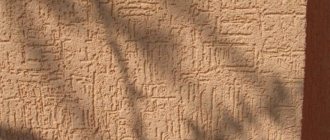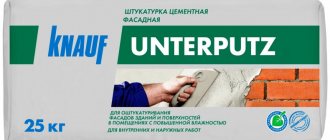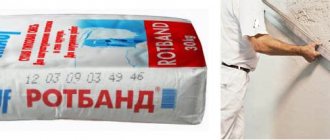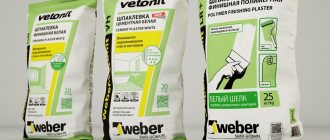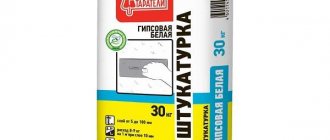05/10/2018 Gypsum plaster is a common finishing material used for repairs and furnishing of rooms with normal humidity. Today the construction market offers a wide range of such products. This allows you to select the appropriate option based on the requirements: place of application (ceiling, walls, inside, outside), application technology, consumption, type of subsequent finishing, color, packaging, technical characteristics, price, etc. Before purchasing, we recommend that you find out what differences between gypsum plasters should be taken into account, how to choose the material correctly and according to what parameters.
Plaster - what is it
Gypsum plaster is a dry mixture (rarely ready-made) intended for interior finishing work. With its help, you can quickly correct various types of defects and surface unevenness.
Gypsum plaster contains natural gypsum. Increased absorption and hydrophobicity promote the penetration of moisture into the layers of the material, due to which favorable microclimatic conditions are formed in the room.
As can be seen in the photo of gypsum plaster, dry mixtures have a dark gray color and a granular fraction. The higher their viscosity, the more convenient it will be to finish them.
Advantages and disadvantages of gypsum-based plaster solutions
Let's look at the pros and cons of gypsum plaster. The advantages include:
- high speed of application and drying;
- good elasticity of the mixture;
- versatility (can work on different types of surfaces);
- possibility of one-stage plastering;
- excellent quality of the result;
- vapor permeability properties;
- antiseptic qualities;
- Requires a minimum of finishing putty.
Minuses:
- low strength;
- low resistance to moisture;
- does not tolerate sudden temperature changes.
Rating of plaster mixtures
If there is construction or renovation ahead, then it’s time to think in advance what materials you should stock up on for plastering the walls. First of all, this concerns leveling compounds, which are required more than decorative ones.
Leveling plaster mixtures can be prepared independently, knowing the proportions, or you can buy ready-made (from the “just add water” series) dry powders (hereinafter referred to as SS). The difficulty of choosing lies not only in the base (binder), but also in the fact that many compositions based on one, for example, cement or gypsum binder are produced.
By what criteria do craftsmen choose plaster? What considerations should a beginner follow? Which type should I choose to plaster a room where humidity is high? What is suitable for leveling walls, after which puttying will not be required?
Briefly about the types of plaster compositions, depending on the binder (base).
Classic materials of mineral plasters, the binders of which are:
- gypsum (dehydrated natural mineral);
- lime (slaked or quicklime);
- cement.
Their differences, which most influence the choice of plaster:
- strength of the formed coating;
- resistance to wet conditions;
- workability and other working qualities;
- terms of plastering work, including drying time;
- price.
Strength and resistance to wetness determine the area of application of plaster materials: cement compositions are most suitable for facade work, gypsum compositions are not suitable at all. When choosing CC for interior work, the ability to maintain a comfortable microclimate for residents and workability (if wallpaper or painting is planned for interior decoration) come to the fore.
Here, gypsum has no equal (with the exception of rooms associated with temporarily increasing humidity, for example, a bathroom). Gypsum “breathes”, allowing the walls to “breathe”, it is also warmer to the touch (another comfortable quality), and with a large thickness of the coating, it significantly participates in heat conservation.
In terms of “working” qualities, gypsum materials are more convenient. They are lighter in weight (important for workers and for walls), more flexible, and set quickly. The ability, when hardening, not to shrink in the case of weak foundations, lifts gypsum high above its competitors.
Gypsum plasters have been developed that do not require puttying. If a thick layer is needed to level the walls in an apartment, gypsum provides the opportunity to create a coating from one layer, saving the time and effort of plasterers. For example, most gypsum mortars can be laid up to 5 cm thick.
A comparison of plaster mixtures on gypsum and cement bases (as a guide for beginners) is presented in the article. Making a further choice of plaster, the main component of which is gypsum, is probably more difficult than others.
Beginners who do not have much experience turn to those who are more experienced for advice on forums. More often, the conversation is about branded materials such as Knauf and Volma products, which is understandable given the history of their appearance in Russian construction spaces.
The popularity of some does not mean the lack of merits of others SS. The downside of popularity is often the rise in price of products outside the production premises.
This, as well as the possibility of “running into” a fake brand, encourages the user to look for a replacement for “celebrities”. In this case, ratings based on the following criteria come to the rescue:
- area of application (or purpose), which includes the possibility of use on facades or interiors, but also applicability for machine plastering;
- composition or components of the product, due to which the mixture has special properties, for example, increased heat retention;
- price (not only per kg, but also the final cost of the coating);
- expert opinion (based on the “working qualities” of the solution, the quality of the final product);
- reviews from consumers (experienced plasterers, beginners, homeowners).
Application Features
How to plaster with gypsum plaster? First of all, prepare the solution:
- mix the dry mixture with water in proportions 2 to 1;
- For better mixing, use an electric drill with a mixer attachment.
Applying plaster yourself is carried out in several steps:
- It is necessary to clean the surface from dirt and old finishing elements.
- It is necessary to treat the wall with a deep penetration primer.
- Install the beacons in increments of 30-50 cm using a building level.
- Throw the mortar onto the wall and level it using the rule.
- After a couple of hours, apply a layer of putty.
- Level the surface using a wide spatula.
In conclusion, we note that when choosing plaster, you should not try to save money. This may affect the quality of the finished result. Therefore, it is necessary to choose only products from trusted manufacturers and carefully read the attached instructions.
Common Questions
Is it possible to use gypsum mixture that has expired?
Conduct a test batch of the solution and try working with it. If the plaster is plastic and adheres well to the surface, and hardens within the time indicated on the packaging, it can be used.
The workers suggested drying the gypsum plaster with a heat gun to speed up the repair. Is it possible to do this?
No. Forced drying with any heating devices will lead to cracks. At high air temperatures, moisture leaves the top layer and remains inside. Therefore, swelling of the plaster occurs. Plus, fungus begins to form inside.
Is it possible to mix leftover plaster from bags from different manufacturers?
If the composition and proportions of the components are absolutely identical, it is possible. The main thing is not to mix mixtures of different compositions and purposes.
Is it possible to use gypsum plaster on a glazed loggia?
This is only possible if the loggia is insulated and dry. If the temperature in winter drops below + 5 degrees, in the spring, when the weather gets warmer, the plaster will begin to peel off.
If work was done on gypsum plaster in the summer and it dried out, the house would not be heated during the winter. Is there a chance that it will move away from the walls in the spring?
If the work was carried out in the summer, and the plaster has dried, and in rooms that have overwintered without heating, there are no drafts or water leaks from the roof, then the likelihood that it will move away from the wall in the spring is minimal. The adhesion of gypsum plaster is high, and it is difficult to detach it from the base after setting.
Is it necessary to putty the wall after gypsum plaster before painting?
If glossing has not been carried out, it is definitely necessary.
The gypsum solution hardens too quickly, what should I do?
You can mix a small volume of solution with the addition of retarders for testing. If retarders do not help, make smaller batches in order to have time to work them out.
